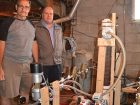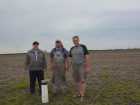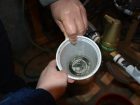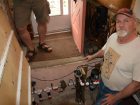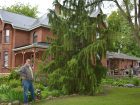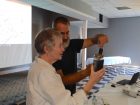
News
Turbidity and turbines?
Citizens and scientists seek solutions to water-well issues in Chatham-Kent, Ont.
June 11, 2019 By Colleen Cross
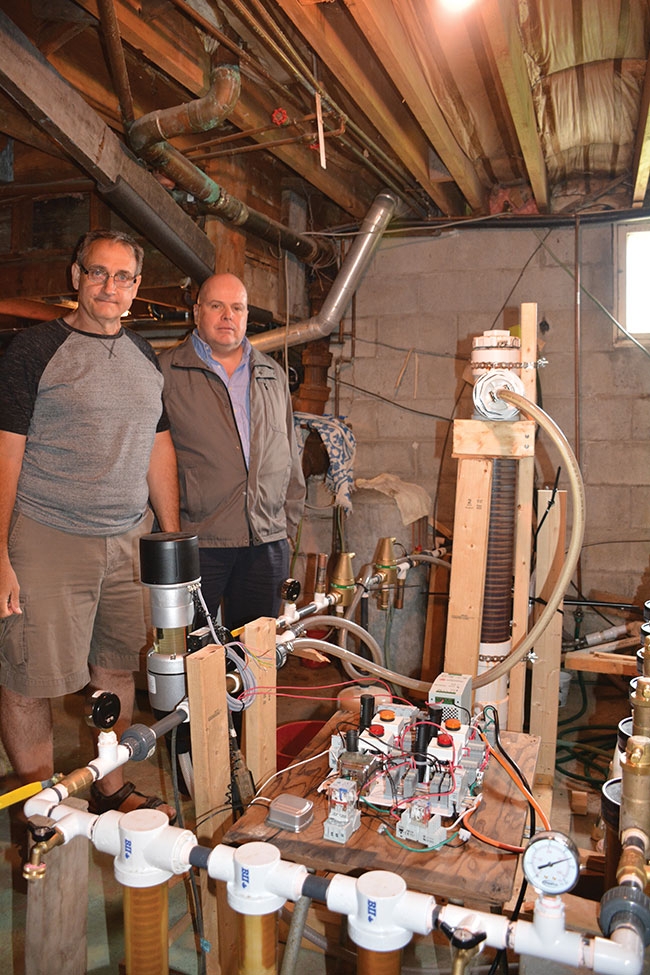 Kevin Jakubec and Joel Gagnon stand beside an elaborate water filtration system Jakubec engineered to try to get Dave Lusk’s water up to potable quality.
Kevin Jakubec and Joel Gagnon stand beside an elaborate water filtration system Jakubec engineered to try to get Dave Lusk’s water up to potable quality. There’s something in the water wells in Chatham-Kent. Excessive sediment, problematic gases, and offputting, potentially infection-causing biofilm.
Since August 2013, water-well owners in the largely rural municipality of about 100,000 residents in southwestern Ontario have seen their well water turn dirty, fill with brown or black sediments that clog filtration systems, expel gases, smell bad. For many, the water was not good enough to bathe in, let alone drink.
These wells have provided good quality drinking water for decades to residents and their livestock and farms. They draw from the fragile contact aquifer that occurs at the contact between the glacial overburden and the Kettle Point shale, which is known to contain elevated concentrations of heavy metals such as arsenic, copper, lead and uranium. The properties are documented in studies, including those by the Ontario Geological Survey and the Geological Survey of Canada in 1985 and 1993, respectively. Hydrogeologist Bill Clarke describes the local geology as consisting of “a thick sequence of both till and deep-sea sediment.” Historically, when drilling wells, Clarke says, “drillers looked for fractured shale or a thin, sandy bed lying on top of the bedrock. They sometimes had to try up to six times.”
Why the widespread changes in well water after water had been good for over half a century? Many are convinced the aquifer has changed – not the wells – and those changes are linked to the construction and operation of industrial wind turbines in the area, namely, the Marsh Line, East Lake St. Clair and North Kent 1 projects. One resident, Kevin Jakubec, has taken his concerns to another level. Jakubec, an area resident and farmer, set out to get answers from wind turbine companies and the provincial Ministry of Environment and Climate Change. Frustrated by the lack of information available and an apparent lack of interest in solving the well problems, he formed a citizen activist group called Water Wells First in 2016 to draw attention to the issues.
Since then, Water Wells First – which is not against wind energy but instead focuses on ground water protection – has staged peaceful protests, attracted extensive coverage by local and national newspapers, radio and TV, and lobbied local and provincial governments and wind turbine developers to halt construction on North Kent 1 and other proposed projects and do further testing. They are on a continuing quest to find answers to a host of problems seen in wells near the turbines.
What followed is a tale marked by too many twists and turns and political machinations to cover in these pages (for background see Ground Water Canada’s fall 2016 edition). We will focus on the work being done by Jakubec and the residents to solve the issues and make the water useable.
TWISTS AND TURNS
To make a long story very short – a story that includes the group’s appeal of North Kent 1’s Renewable Energy Approval – the ministry concluded the issues in about 20 complaints from well owners filed under the Well Interference Protocol (remedial steps approved by the MOECC that may be taken to address complaints of damage to a well or well water quality) could not be attributed to turbine construction or operation.
In a February 2018 YouTube video that describes studies commissioned by North Kent 1 developers Samsung and Pattern Energy, a Golder Associates consultant found no plausible way particles could be transported hundreds of metres from turbine locations to water supply wells. “This is narrow thinking,” Bill Clarke says. “It’s not about a plume, it’s about vibration. It’s as if four or five of us were to take turns throwing a pebble into a pond. This creates a pattern of cancelling and reinforcing waves. Private wells are located in a spot among the turbines where multiple vibration patterns happen. This would cost millions and require years of study to prove or demonstrate.”
Jakubec, who has a degree in biology, did extensive research and has a theory that relates to vibration: a phenomenon known as seismic coupling. “It’s been well documented in scientific literature that a wind turbine can shed ground water vibrations into the local ground during operation,” he says, pointing to the work of Mark-Paul Buckingham at Xi Engineering in Scotland. Locally sourced particles enter the wells during pumping. Particle transport over long distances is not required for wells to be impacted.
BASELINE TESTING
Early on, Water Wells First had support from the Ontario Ground Water Association, and through them contracted Bill Clarke to perform independent baseline testing at a cost of $2,000 per well on several area wells before and after construction of North Kent 1 began. “There is no doubt in my mind this is well interference,” says Clarke, who wrote two articles describing his findings and opinion in Ground Water Canada in 2018.
Clarke did chemical testing and found elevated concentrations of particles under two micron in several wells, including a huge jump in one well. He detected no dissolved metals in the water. But he and Jakubec are more concerned about the fine particulates than the dissolved metals. “Fine particulates don’t settle out, they stay in suspension, and in time they migrate,” Jakubec says.
Clarke collected sediment samples at the same time. “They have no shelf life, so I took them to save for future use in case they are needed later,” he says. The hydrogeologist gives weight to anecdotal evidence and common sense. “I got to meet a lot of people,” he says. “It was common to hear from second-generation residents, many of them farmers, the words ‘I’ve never seen water like this.’ Their systems were blocked and you could see discoloration in sinks, bathtubs and washing machines.”
WORTH STUDYING
Joel Gagnon, associate professor in the Department of Earth and Environmental Sciences at the University of Windsor and head of the metals lab at the Great Lakes Institute for Environmental Research (GLIER), presented a set of water quantity and quality problems at the Ontario Ground Water Association banquet and awards ceremony in March 2019. The talk told “a tale of two wells” and generated new interest in the Chatham-Kent issues.
Gagnon, who grew up in the area, set out to find interesting research problems with the intention of applying for funding to study them.
“My role is to use this situation as best we can to provide learning opportunities to students. That started out as field trips with students,” he says. After visiting several residences, he chose two for further evaluation: Dave Lusk’s farm on Green Valley Line and the home of Marc and Marilynn St. Pierre on Bay Line near Mitchell’s Bay.
His team collected water samples and wrote up their preliminary findings with the goal of applying for funding to do research. He described the problems reported at two homes and talked about the potential and need for scientific study of the well issues, which include excessive turbidity – fine-grained suspended particles causing filters to fail in seconds to minutes – low yield, no yield, and gas, which is mostly methane but could also contain radon. In the case of the St. Pierres’ well, they also found biofilm, which had a slimy texture, black colour and sulphurous odour, and appeared to contain sulphate-reducing bacteria.
Gagnon is especially concerned about radon, which was detected in ambient air in Lusk’s basement at a level just below the threshold considered hazardous and requiring remediation.
“There’s a lot of uncertainty,” he says. He is trying to raise questions about water treatment, water quality, potential health risk from water or gas or both. Gagnon would like to see an assessment of the region to decide how extensive this problem is. Then toxic metals as they relate to the quality of water in the area need to be assessed. He wants to look at patterns within that study to see if locations of the metals might correlate with turbine operation.
Gagnon is focusing on quality of water, distribution of sediments, dissolved metals, dissolved gases: What does it look like? How do you treat the water? Is there evidence of statistically significant human health impacts related to the Kettle Point shale (even without turbines) that exceed the level you would expect?
A TALE OF TWO WELLS
Gagnon and Jakubec accompanied Ground Water Canada on a visit to the two sites – the homes of Dave Lusk and Marc St. Pierre. It was Gagnon’s third visit and one of countless visits for Jakubec, who has helped his fellow well owners rig up water treatment systems that must be seen to be believed. We will get to that.
Dave Lusk is a fourth-generation farmer who lives on Green Valley Line in Chatham township. He grows corn on land his great-grandfather developed. On an overcast day in May, Lusk shows us to his wellhead, which is about a kilometre and a half away from the nearest wind turbine. Within sight is a decommissioned well his grandfather drilled that provided good water for workhorses for many years. Lusk’s well is 49 feet deep and the static water level is 10 to 20 feet below ground. Intake is at the top of the aquifer, just above the shale bedrock.
Since 1966 his well has provided excellent water to the household and farm. In 2017, Lusk started noticing fine brown sediments in his water, which made drinking the water impossible and bathing with it unpleasant and worrisome.
There is no doubt in Lusk’s mind the trouble began with construction of 34 North Kent 1 turbines. Thirteen piles were driven into the bedrock using a steel tube with hardened drive shoe beginning on Aug. 24, 2017. During pile driving, the well began expelling natural gas at a rate that caused water to be ejected from the top of the well casing. Lusk took a video of the alarming phenomenon Gagnon refers to as “self-sparging,” to borrow a term from ground water treatment strategies that involve injection of air into an aquifer. “Gas that’s dissolved in the water is exsolving because of the reduction of pressure at the well,” he explains.
After testing Lusk’s water, AECOM, the wind developers’ consultant, provided him with an alternative water supply. But when the company said it was no longer required and suggested Lusk keep it as a gift, he declined. Instead he bought a large tank, which he keeps in his shed for outdoor, non-potable uses. He doesn’t like the notion of trucked-in water.
“But the worst thing is the stress,” Lusk says during our visit. “Every minute of every day. It’s disheartening as hell. I can only talk about it for so long, then I have to stop because I get too upset,” he says.
Lusk keeps chickens but he no longer gives away eggs to family and friends for fear they are contaminated. Nor does he garden anymore. “I used to grow a vegetable garden. It was a stress reliever for me. Now I wouldn’t eat the vegetables.”
The situation has left him feeling helpless and as if he is letting his great-grandfather down. And there are fifth and sixth generations being affected by the well issues. His daughter wants to take over the farm but he can’t in good conscience let her. “I don’t want my daughter here. It’s not safe for her children,” he says. “We now have to teach the kids not to drink the water, just like we would teach them not to touch a light socket.”
Lusk is currently drinking bottled water; until recently he was drinking well water but stopped when he got sick.
LUSK FARM: ‘TREATMENT TRAIN’
Jakubec and the well owners have not waited around for answers from the government. They are forging ahead with their own solutions to well issues. One such solution is a system Jakubec calls a “treatment train” that aims to remove the Kettle Point black shale particles and reduce the amount of shale gas entering Lusk’s home water supply.
We troop down into Lusk’s basement to have a look at the system, which fills about half the basement and is flanked by a washing machine and dryer. Jakubec’s “treatment train” would rival any scientific lab and calls to mind 1950s sci-fi movies.
“It is based on a brute filtration method where you start with the coarser particles then work your way down to smaller and smaller ones,” Jakubec explains. “The technology they are using is the same technology used in wastewater treatment.”
He describes the key elements of the elaborate system: a spin-down trap with a coarse sediment filter to keep sediment from accumulating; a piston pump; Taco air strippers to remove exsolved gases; water hammer/surge arrestors to dampen the water-hammer effect produced by gas exsolution, reduce pressure fluctuations and improve filtration efficiency; a magnetic filter with a three-quarter-inch looped hose and two 600-pound pull magnets at the bottom of the loop to magnetize and settle the particles, which helps slow the backwash to every 20 minutes; a self-cleaning Judo filter with a screen to help remove particles above the 30-micron size range; a 60-micron spin-down filter followed by two 30-micron spin-downs; six commercial grade filters (60 per cent efficient) to remove as much fine particle load as possible; and three high-grade filters. After treatment the water is brute-scrubbed to 0.2 micron, Jakubec says. A water meter to give readings of water flow.
All of this is monitored through a control panel that sits in the middle of the train. The Judo filter is linked to voltage dataloggers that document every backwash cycle triggered. This is to prevent the filtration system from plugging with sediment, burning up the electric motor and possibly damaging the pump. It also lets Jakubec and Lusk track the amount of sediment loading to outside weather and turbine operating conditions such as wind speed and wind direction.
While we are there an old-school alarm bell goes off. Jakubec climbs in among the pipes and components to turn off the system and take a sample from the spin-down filter. He leans forward to show us a cluster of fine brown particles that resemble iron filings settling at the bottom of a cup. He then pulls out a filter cartridge and reads off the numbers to Lusk, who records them on a wall chart. To date, Lusk has invested about $8,000 into the system.
‘REDNECK ENGINEERING’
Jakubec calls his system a form of “redneck engineering” and likens it to a game of whack-a-mole. “As soon as you figure out one problem, another pops up,” he says. He has support from Joel Gagnon and a local electrical engineer.
“We’ve learned a lot in trying to filter this water that’s clearly been interfered with,” Jakubec says. “It’s been a great learning experience and we’ve learned there are a number of problems we have to solve simultaneously, which makes it an incredibly hard engineering problem to solve. If there are any engineers that want to give me a call, I would welcome any advice you could share with me.”
“All of this is just basically to address esthetics and to make the water usable,” Gagnon points out. “They haven’t even got to the point of assessing the efficiency of the system for addressing water chemistry.”
Lusk also has to change or wash filters every week or so. He’s changing them sooner than that day of my visit because it’s been windy lately, Jakubec speculates. It used to cost him $3-4 per month to run the pump and water treatment was unnecessary. Now it is costing thousands.
ST. PIERRE HOME: ALL THAT AND BIOFILM
Nearby on Bay Line, Marc and Marilynn St. Pierre have similar issues with their well since turbines were built – less gas than at Lusk’s but the unwelcome addition of biofilm. Their large red brick house and property, where they’ve lived since 1980, is near the East Lake St Clair Wind project in Dover township.
The St. Pierres’ well was constructed in 2006 to replace an older well due to water quality issues that started during installation of the turbines. The new well is 66 feet deep and terminates in the contact aquifer. It had good pumping capacity but was full of fine black sediment, was cloudy, had an unpleasant smell, and possibly pathogenic biofilm. Rehabilitation of the well by a licensed water-well contractor using surging, bailing and purging methods helped reduce sediment and biofilm; however, the biofilm returned within six months.
The water issues have meant high stress for Marilyn, a cancer survivor who has been cancer-free since 2005. She is terrified of going through that again, Marc says. Their family has included their five children and more than 80 foster children over the years. The well passed strict inspection by Children’s Aid Services as part of standard home inspections of foster parents and water quality issues developed only after turbine installation and operation.
Jakubec has helped the St. Pierres set up a system very similar to the treatment train in Dave Lusk’s basement, with three major differences: it employs a submersible rather than a piston pump, it must deal with biofilm issues and it’s smaller (about a quarter of the footprint).
St. Pierre, a former engineer, installed a Seccua pump with a water tank. The filtration system was designed to filter glacial milk and provides microfiltration meant to go to the colloidal level, Jakubec says. They customized it to filter tiny black shale particles and biomass.
He invites us inside to see the system, which is hidden under a trap door he built just inside the main doorway of the house. He has put in a heavy-duty house filter designed for black water. He too has a Taco filter and surge-arrestors. It may seem like overkill, he says, but “everything is built to protect.”
“I’m kind of proud of it,” St. Pierre says from down in the treatment train.
The water is filtered to 0.01 micron, the NSF standard. It is smooth, good-tasting and sweet – a trait area water has been known for.
As with Lusk’s well, a northwest wind affects the nearby wind turbine and, thus, the operation of the treatment system. St. Pierre knows this because he sees a visible change in water quality and the treatment system monitor sends a pulse indicating loading rates have changed.
They now drink the water, but for the St. Pierres, this experience has meant stress, worry and around $15,000 in unplanned expenses. Like Lusk’s treatment system, theirs has addressed esthetic issues. Its ability to address potential health risks associated with consuming the water is yet to be determined, Gagnon says. In both cases, these assessments will be undertaken once the configurations of the systems are finalized.
PROBLEMS GO UNREPORTED
After investigating the situation, Gagnon recommended to the Ministry of Health a regional study of the contact aquifer to look at baseline water quality, temporal and spatial variability, and the nature and extent of impacts on ground water. He also believes the Kettle Point aquifer’s shale chemistry requires more study: are there leachable metals in it, and if so, in what amount? Are there hazardous organic compounds or gases? Lastly, he’s pushing for toxicity and hazard assessments that would look at potential ingestion, inhalation and dermal contact exposures, methylation of metals and explosive and hazardous gases.
Jakubec and Gagnon estimate water-well quality in at least 80 wells has been affected by turbine activity, possibly twice the number of problem wells reported. In response, some well owners use water tanks, some filter the water and some use bottled water. The extent of the risk to residents’ health is not known in part because sampling has been done by the MOECC only in response to well owner complaints. Many residents experiencing well issues, however, have not reported them, Gagnon says, citing as possible reasons fear that a complaint will lower property values, reluctance to get involved or draw attention and the legal obligation not to talk about the matter after having signed turbine lease contracts or having accepted water treatment systems from wind energy companies that included non-disclosure agreements.
The potential for health issues prompted Gagnon to share his findings with the Ministry of Health last November. The ministry has not responded other than to say the information Gagnon provided was given to its policy team.
“People should be apprised of any potential health impact, and should they have the opportunity to treat it, they should be aware of that. Then there is the larger question of should we allow ground water resources to be destroyed or should we protect them?”
Gagnon and Jakubec are now experimenting with magneto-electro coagulation to reduce the amount of sediment in Dave Lusk’s well. They will continue assessing treatment options in the hopes of finding a solution that is lower in cost and less complex than the current system.
“What’s been lost in all this is the loss of use,” Gagnon says. “This isn’t just a question of health . . . but of the practical challenge of using the water and the costs residents have incurred. These are costs that people never had before.”
A WISH LIST
Jakubec advises well owners anywhere near proposed construction or other major construction projects that might impact ground water to get a baseline test for their water quality. Without baseline tests, impacts to ground water quality are very difficult to argue. Water well records, documented flow rates and well surveys should also be recorded, adds the OGWA’s Craig Stainton.
He wants the provincial government to do a health hazard investigation. Jakubec, Clarke and Gagnon agree that a committee made up of different disciplines is needed to come up with solutions.
“If we don’t do a study and we find out years down the line that people in Chatham-Kent have illnesses, who will pay for this tragedy?” Clarke wonders. “Why not stop, reflect on what we don’t know.”
Kevin Jakubec welcomes advice and ideas from readers: 519-350-9458, contactaquifer@gmail.com or through waterwellsfirst.org. Read a column by editor Colleen Cross on this issue.
Print this page
